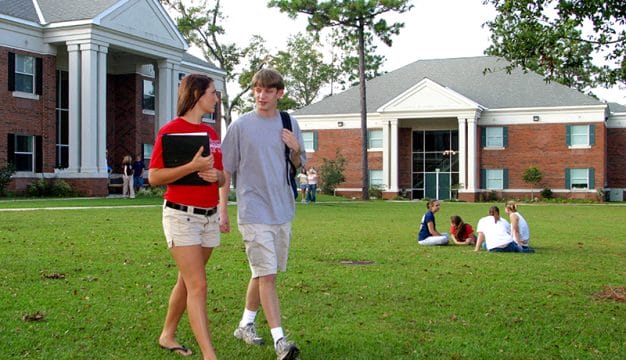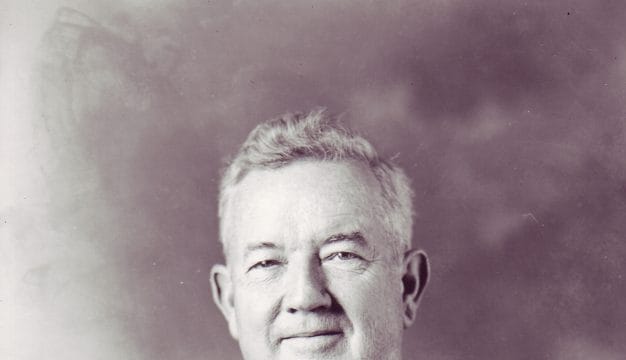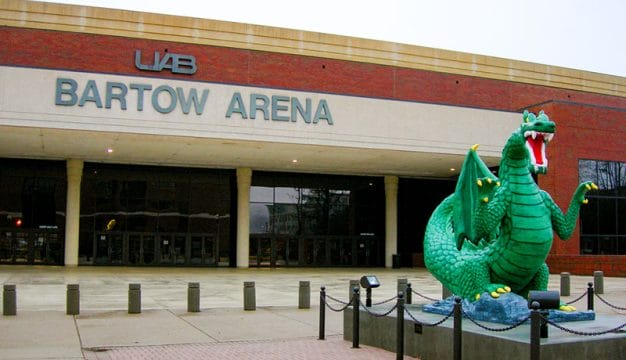Stillman College
Stillman College, in Tuscaloosa, is a four-year liberal arts college offering bachelor’s degrees in the humanities, the natural sciences, the social sciences, and business, with a current enrollment of approximately 1,000 students. One of Alabama’s Historically Black Colleges and Universities (HBCUs), it is affiliated with the Presbyterian Church USA.
Stillman Institute—later Stillman College—was founded in 1876, at the end of Reconstruction and the beginning of a difficult period for African Americans in the South. Its story actually begins
 Stillman College
earlier, before the Civil War, however, when a group of white Presbyterians at Tuscaloosa’s First Presbyterian Church, concerned with the plight of people of color, initiated the “Sunday School for Negroes.” The Sunday School eventually evolved into Salem Presbyterian Church, a predecessor of Brown Memorial Presbyterian Church in Tuscaloosa. In 1875, Charles Allen Stillman, who had become First Presbyterian Church’s pastor in 1870, sent an overture to the General Assembly of the Presbyterian Church in the United States (the Southern Presbyterians) proposing a training school for black ministers. In 1876, the General Assembly authorized the seminary, and it opened in the fall of that year, with Stillman and one assistant teaching classes in Bible, theology, homiletics, reading, speaking, and philosophy. In 1881, the Stillman House was built for the school on 21st Street in Tuscaloosa. During the school’s early years, the annual enrollment was about 15 students.
Stillman College
earlier, before the Civil War, however, when a group of white Presbyterians at Tuscaloosa’s First Presbyterian Church, concerned with the plight of people of color, initiated the “Sunday School for Negroes.” The Sunday School eventually evolved into Salem Presbyterian Church, a predecessor of Brown Memorial Presbyterian Church in Tuscaloosa. In 1875, Charles Allen Stillman, who had become First Presbyterian Church’s pastor in 1870, sent an overture to the General Assembly of the Presbyterian Church in the United States (the Southern Presbyterians) proposing a training school for black ministers. In 1876, the General Assembly authorized the seminary, and it opened in the fall of that year, with Stillman and one assistant teaching classes in Bible, theology, homiletics, reading, speaking, and philosophy. In 1881, the Stillman House was built for the school on 21st Street in Tuscaloosa. During the school’s early years, the annual enrollment was about 15 students.
Stillman’s most distinguished graduate, William Sheppard, studied for the ministry at Stillman House from 1883 to 1886; Sheppard became a missionary to the Belgian Congo (now the Democratic Republic of the Congo), where he exposed atrocities perpetrated by commercial interests against the people of the Kasai region; he was charged with libel by the Kasai Rubber Company, and his trial (in which he was acquitted) brought international attention to the systematic abuse and murder of African people in the rush to plunder the continent’s wealth.
Stillman served as the superintendent of Stillman Institute until 1893, when poor health forced him to pass the post on to minister Alexander Lacey Phillips. Under Phillips, Stillman Institute’s curriculum continued its focus on theology, but he also initiated efforts to address the poor background in academic subjects displayed by many of the students. He established a three-year course of academic study with instruction in math, science, English, history, psychology, and geography. In 1898, the school purchased the former Cochrane plantation house and 20 acres of land on the west side of Tuscaloosa, which remains the site of the present campus, on the street that is now Stillman Boulevard. In its new location, the institute established a farm, where students could work for their room and board. The Cochrane home was used as a student residence for a time but was soon demolished because of its poor state of repair. Today the marble columns from the Cochrane home grace the façade of Stillman College’s Sheppard Library.
A secondary school was added to the ministerial school in 1899, when non-theological students joined the student body and the first women were admitted as day students. At this time, the curriculum included vocational and practical skills, including instruction in farming methods. Also in 1899, the Presbyterian U.S. General Assembly approved the opening of the school to all who wished to enter. From that time until the present, children of white faculty and administrators could be found among the generally African American student population. As later President Cordell Wynn once wrote, Stillman Institute/College in effect has been integrated since the end of the nineteenth century.
Phillips was succeeded by Reverend O. B. Wilson, who was killed during a telephone conversation when a bolt of lightning hit the wires. Wilson was followed by superintendents James C. Snedecor, Ebenezer Hutchinson, and R. K. Timmons.
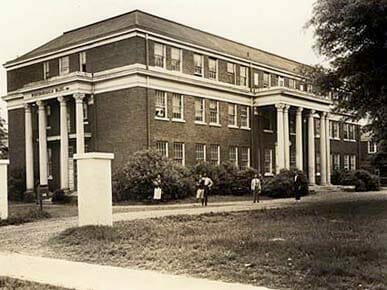 Winsborough Hall at Stillman College
In 1912, Hallie Paxton Winsborough became secretary of the Woman’s Auxiliary of the Southern Presbyterian General Assembly. She sparked interest in providing more opportunities for women students at Stillman Institute, and in 1918 the Presbyterians made an appeal for funds to build a women’s dormitory. In 1922, the building, named Winsborough Hall, was completed, and Stillman Institute became fully coeducational. From 1926 to 1929, Stillman reorganized the secondary school offerings into junior and senior high school divisions, following the standards of the Alabama State Department of Education. The high school was accredited in 1929.
Winsborough Hall at Stillman College
In 1912, Hallie Paxton Winsborough became secretary of the Woman’s Auxiliary of the Southern Presbyterian General Assembly. She sparked interest in providing more opportunities for women students at Stillman Institute, and in 1918 the Presbyterians made an appeal for funds to build a women’s dormitory. In 1922, the building, named Winsborough Hall, was completed, and Stillman Institute became fully coeducational. From 1926 to 1929, Stillman reorganized the secondary school offerings into junior and senior high school divisions, following the standards of the Alabama State Department of Education. The high school was accredited in 1929.
Stillman Institute opened a junior college division in 1927, during the tenure of Superintendent William Forney Osborne. Also in that year, the Presbyterian Women’s Auxiliary raised funds to establish a nursing school. The Emily Estes Snedecor Nurses’ Training School and Hospital was opened in 1930 and operated until 1946.
During the Great Depression, the Presbyterian Committee on Colored Ministry decided to close the institution. Superintendent Ashel Jackson met a group of committee members and church leaders literally at the gates of Stillman Institute and asked to be allowed to continue trying to keep Stillman afloat and was granted permission to do so. Throughout the depression years, the students grew most of their food on the farm, and Jackson went to the Tuscaloosa Farmers’ Market every week to sell and buy vegetables. Jackson and his wife—who served as Dean of Women, taught classes, and performed a heavy round of other duties—went without pay for a year. The school survived, and in 1937 the junior college was accredited. In 1940, Jackson’s title was changed from superintendent to president. He was succeeded in this position by Rev. Alex Ramsay Bachelor and Dean B. Brewster Hardy (1947-48).
In 1948, during the administration of Samuel Burney Hay (1948-1965), Stillman became a four-year college. Enrollment dropped off, especially among male students, during World War II, but the theological department already had declined by this time, and by 1946 there were only two ministerial students. The theology
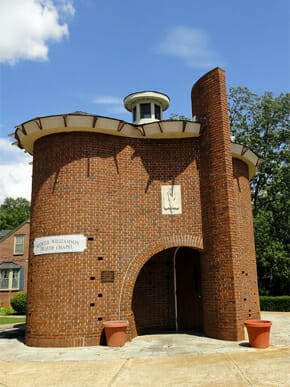 Stillman College Chapel
program was thus abolished. In 1949, Stillman Institute was renamed Stillman College and was accredited in 1953. New construction during Hay’s presidency included a gymnasium, Hay College Center, a classroom building, a prayer chapel, and two residence halls. Hay was succeeded in 1955 by Knute O. Broady, who served as interim president until 1967, when Harold N. Stinson, Stillman College’s first African American president (1967-1980), assumed the position.
Stillman College Chapel
program was thus abolished. In 1949, Stillman Institute was renamed Stillman College and was accredited in 1953. New construction during Hay’s presidency included a gymnasium, Hay College Center, a classroom building, a prayer chapel, and two residence halls. Hay was succeeded in 1955 by Knute O. Broady, who served as interim president until 1967, when Harold N. Stinson, Stillman College’s first African American president (1967-1980), assumed the position.
During the civil rights era, the Stillman College administration’s policy urged caution, but many students participated in rallies, demonstrations, and other civil rights activities in Tuscaloosa. In 1963, a group of students at Stillman served as a support group for friend Vivian Malone as she and James Hood registered for summer school at the nearby all-white University of Alabama. During the student demonstrations of the 1960s, a group of Stillman students occupied Hay College Center for several days. The students finally relented when President Stinson had the water and the electric power to the building turned off. During Stinson’s tenure, the college constructed a new classroom building, now called the Harold N. Stinson Math and Science Center. In 1980, after illness forced Stinson to retire, former dean B. Brewster Hardy served as interim president for two years.
In 1982, Cordell Wynn became president, and during his tenure the college topped 1,000 students and added the Marie Lundy Wynn Residence Hall and the Johnson/Robinson Health Center. Wynn also initiated a campaign to build a Humanities and Fine Arts Center and increase the endowment from $2 million to more than $20 million. The Stillman Management Institute and a community-service outreach program were also established at this time.
Ernest McNealey became president in 1997. Under his leadership, Stillman College earned a top-tier ranking among comprehensive colleges in the South, strengthened its faculty from 43 percent to 80 percent of full-time faculty with terminal degrees, and achieved the first accreditations for specific disciplines—in music, business, and education. Admission standards were raised and instructional technology was greatly expanded. A nursing program was reinstituted in 2007. New construction included a Fine Arts Center, a Teacher Education Center, an additional residence hall, a stadium, and a formal campus entrance and imposing fence. In 2015, Peter Edmund Millett became president and served for two years. In 2017, Cynthia Warrick became interim president.
Today, Stillman offers traditional liberal-arts courses and several pre-professional majors, as well as special academic programs including night school, the Harte Honors College, Military Science (ROTC), the Program in Experiential Learning, and the Stillman Management Institute. Extracurricular opportunities include a large variety of sports, Band, Scholar Bowl team, newspaper and yearbook staffs, and the renowned Stillman College Choir, which has performed all over the United States and abroad.
Although it is now governed by a self-perpetuating board of trustees, Stillman retains strong ties to the Presbyterian Church USA; Presbyterian bodies including the Presbyterian Women’s Organization frequently meet on the campus, and Brown Memorial Presbyterian Church is located on the campus. The college is also supported by many alumni who retain their loyalty as Stillman Tigers to the Stillman blue and gold.
Additional Resources
Franklin, Samuel. Stillman College: A Glance at its Past. Tuscaloosa, Ala.: Stillman College Archives, 1974.
Harris, Trudier. Summer Snow: Reflections from a Black Daughter of the South. Boston: Beacon Press, 2003.
Lockett, James. Historical Portrait of the Leaders and Missionaries of Stillman College. Tuscaloosa, Ala.: Stillman College Archives, 2005.
